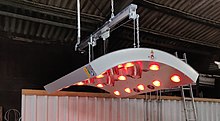Horse solarium
A horse solarium is a technical device for irradiating a horse with infrared and ultraviolet light. Some devices have circulating air systems, hairdryers or light sources for light therapy.
Construction of a horse solarium
The recommended size of the solariums is 2.50 m in width and 3 m in length for large horses. Horse solariums are equipped with lifting devices to be able to place the horses safely underneath and, depending on the size of the horse, to have the correct distance to the horse's back. The device is operated by means of a control box to regulate the intensity and duration of tanning as well as the distance to the horse's back.
Horse solariums can be found in different housing designs. Metal or plastic housings are common, modular constructions can also be found, as well as custom-made products for small horses and ponies.
The number and type of light sources and the equipment with hair dryers varies from manufacturer to manufacturer and depending on the area of application.
Areas of application and mode of action of horse solariums
The use of solariums has been established for sport horses for a long time. The performance-enhancing and health-promoting effect of the radiation can also be used regularly with recreational horses. Depending on how they are kept, these horses also do not always receive sufficient natural sun. In broodmares, fertility can be promoted.
The tanning of horses that are in training, racing and competitions prepares them for work, activates the circulation significantly, warms up the muscles and thus improves performance. After work, the horse can be irradiated immediately, as the tanning soothes, dries the coat and causes complete relaxation.
Twenty minutes a day is enough to activate the positive effects on the horse's organism. In order to give the horse the minimum necessary to maintain health and sufficient resistance, three applications per week are necessary.
See also
literature
- Gerlinde Hoffmann, HD Wagner: Orientation aids for equestrian facilities and stable construction. FN Verlag 2009, ISBN 978-3-88542-740-7 , p. 108.
- Robert Stodulka: Medical riding instruction: understanding, avoiding, fixing training-related problems. Enke 2006, ISBN 978-3-8304-4167-0 , p. 204.
- Deutsche Reiterliche Vereinigung, Bodo Hertsch, M. Düe, G. Hoffmann: Guidelines for Riding and Driving, Volume 4: Keeping, Feeding, Health and Breeding , FN Verlag, 15th edition 2010, ISBN 978-3-88542-284- 6 , p. 207.


